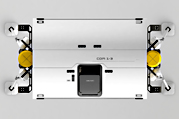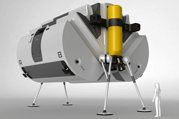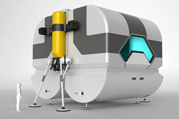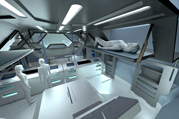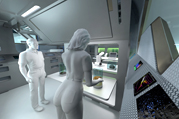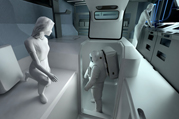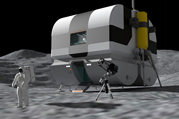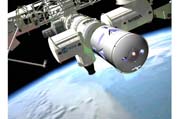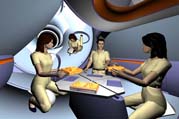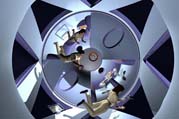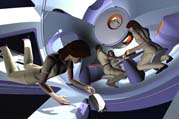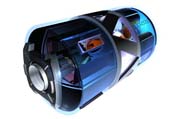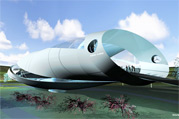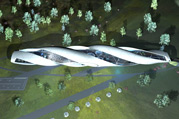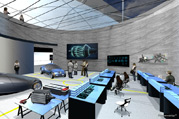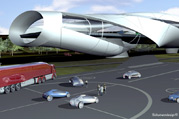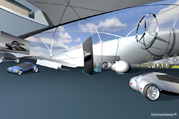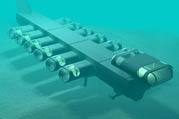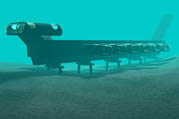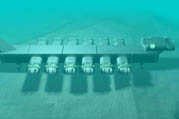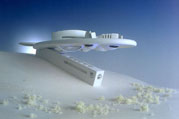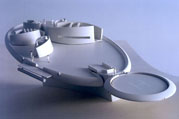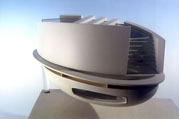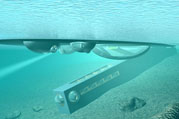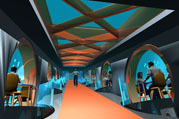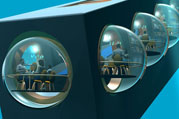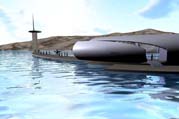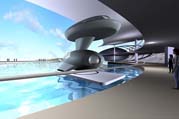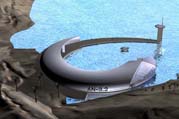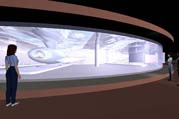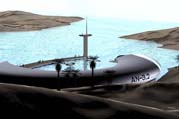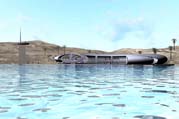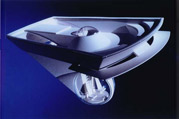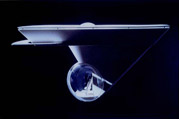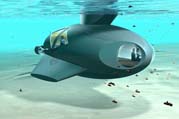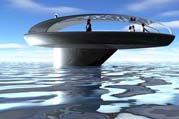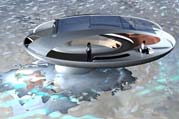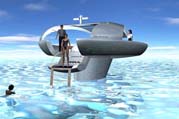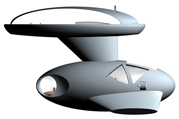Trendsetting architecture / space architecture / maritim architecture
Terra Lunaris
The “Terra Lunaris” project is the third design concept to be developed by the Schumanndesign Studio in the field of space architecture and space technology.
The primary focus of the project is on the practical feasibility of creating a lunar habitat that takes up a minimum of transport space while subsequently offering maximum interior volume – i.e. living space – for the occupants.
By combining solid modular components with an inflatable shell structure, the inside volume available for use as habitable space is almost four times that of the transport volume.
The habitat comes already equipped with pre-installed interior elements, which fold out and make up around 90% of the interior. This therefore almost completely avoids the complex and costly task of fitting such elements after erection of the shell.
The interior layout of the habitat encompasses technical and research areas, communal spaces for the crew members, sleeping quarters, and an observation deck.
In the design of habitats of this kind, the technological requirements play a leading role. However, psychological factors are also a consideration of major importance as the team members find themselves in an extreme living environment. The design therefore also pays close attention to emotional aspects, supporting the sense of safety and wellbeing on the part of the occupants
With projects of this kind, we are beginning to extend our life environment beyond our home planet. We need to approach this not only on the technological plane, but also express our cultural stance and identity in the means of transportation and the habitats that will make this widening of our living environment possible.
Concept & Design: Schumanndesign
Habitat analyses: Dr. Dr. Robert A. Goehlich
Ziolkowski-module
The Ziolkowski Module project is concerned with the concept of an orbital accommodation module which is designed for use in the context of the emerging space tourism business.
A key commercial aspect in the design of the concept is a kind of symbiotic relationship between the module and larger, already existing structures such as the ISS, with utilization of the latter’s infrastructure.
The structure of the module basically consists of three areas.
The A segment contains four separate accommodation areas, which are also of modular design.
These accommodation areas are located as quarter elements around the central connection tunnel that connects the module to the main structure (ISS).
The B segment serves as a communal area; its main function is as a viewing deck.
The C segment contains the necessary service and utility systems.
The key focus in the design of the module is on the aspects of relevance for tourism uses, such as a high enjoyment and event value, but also the need to take account of the psychological situation of “non-professional” visitors to the earth orbit.
The project was first introduced in 2004 at the International Lunar Conference-6 in Udaipur, India; it was subsequently displayed between 2006 and 2007 as part of a special exhibition in the State Museum in Mannheim, Germany, and was presented in 2011 at the 2nd International Space World Conference in Frankfurt. In 2013 an exhibition took place at the Technical University of Tallinn (Estonia) where the project was also shown.
Concept & Design: Schumanndesign
Costing and profitability calucations: Dr. Dr. Robert A. Goehlich
Daimler AG / Sachse Consulting: Development of visions for vacational education and training
The building concept created for Daimler AG serves to develop visions for vocational education and training.
The basic structure is reminiscent of the double helix of human DNA.
It receives all inherited information - the complex blueprint. It stores physical features, functions of the immune system and talents that develop in the course of development.
Abyssale
Abyssale is a concept for a hotel installed entirely underwater, complete with restaurant and other convenience facilities.
An important factor as far as the production and running costs are concerned is that the unit is able to operate under atmospheric conditions.
The modular design further reduces the construction costs and makes it possible for Abyssale to be built with any desired dimensions.
Abyssale is designed for a depth of water of approx. 10 metres.
Like the Kamar concept, the underwater structure is permanently anchored to the sea bed, a site should therefore be chosen which does not already have its own pronounced flora and fauna.
After construction of the unit, the surroundings can be structured with reefballs distributed on the seabed.
The reefballs provide a platform for colonization by all manner of life forms.
This enables a new habitat is able to develop in only a short period of time, which can be viewed from the various observation posts of the installation.
The result is a newly created biotope with all its flora and fauna - similar to the rapid colonization with new life that occurs on sunken ships.
Kamar
Kamar is designed as a permanently installed apartment hotel.
The structure consists of an underwater section containing a submarine restaurant, and a surface platform on which up to 16 apartments are located, each with its own underwater viewing area.
As Kamar is permanently anchored to the sea bed, a site should be chosen which does not already have its own pronounced flora and fauna.
After construction of the unit, the surroundings can be structured with reefballs distributed on the seabed.
The reefballs provide a platform for colonization by all manner of life forms.
This enables a new habitat is able to develop in only a short period of time, which can be viewed from the various observation posts of the installation.
The result is a newly created biotope with all its flora and fauna - similar to the rapid colonization with new life that occurs on sunken ships.
Kamar was included in the 2002 exhibition “European way(s) of life” in the Carrousel du Louvre in Paris and was subsequently shown in the Seoul Art Center.
Marina
Marina is primarily designed to provide service functions for the Palinurus 1.1 and 3.2 concepts, but has been given an additional functionality as an attraction for visitors with an interest in the technical processes involved, which can be fascinatingly presented.
The complex also offers other facilities, such as a restaurant, above-water and underwater viewing areas, or the starting point for excursions with the Palinurus units.
Palinurus 1.1
The Palinurus 1.1 project consists of a general purpose platform located above water and underwater accommodation and viewing areas.
In this concept, observation of the underwater world can take place in a more meditative situation.
The utilization character corresponds more to that of a permanently installed houseboat.
Several units can be grouped together to form a small, floating apartment community.
The project was awarded the international Gold Prize of the Ministry of Export Trade and Industry in Osaka, Japan, in 1997.
Palinurus 3.2
Palinurus 3.2 is the modified version of the Palinurus 1.1 concept and is designed for mobile use.
Like the 1.1 version, Palinurus 3.2 also consists of a general purpose platform above water and underwater accommodation and viewing areas.
The unit offers space for four to six people.
Palinarus 3.2 is highly versatile and combines the comfort and convenience of a yacht with all the attraction and fascination of a submersible.


